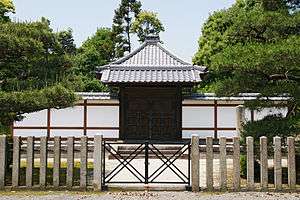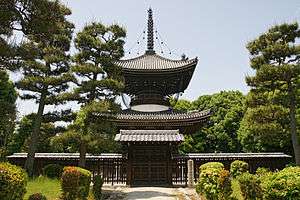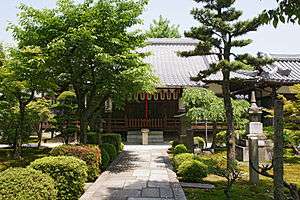Anrakuju-in
Anrakuju-in (安楽寿院) is a Buddhist temple in Fushimi, Kyoto, Japan, built by former-Emperor Toba in 1137. The temple houses a number of Important Cultural Properties and the emperors Toba and Konoe are buried in the grounds. The Ashikaga estate from which the Ashikaga clan derived its name once belonged to Anrakuju-in.[1]

Grave of Emperor Toba

Grave of Emperor Konoe
Important Cultural Properties
- painting on silk of Amida descending with twenty-five bosatsu (絹本著色阿弥陀二十五菩薩来迎図) (Heian period)[2]
- painting on silk of Fugen Bosatsu (絹本著色普賢菩薩像) (Heian period)[3]
- seated wooden statue of Amida Nyorai (木造阿弥陀如来坐像) (Heian period)[4]
- inscribed gorintō (五輪塔) (1287)[5]
gollark: !q give 2 brick <@!258639553357676545>
gollark: !q take 2 clay <@!258639553357676545>
gollark: !q give 400 fuel <@!258639553357676545>
gollark: !q give 1 brick <@!258639553357676545>
gollark: !q take 1 clay <@!258639553357676545>
References
- Plutschow, Herbert E. (1995). Japan's Name Culture: Significance of Names in a Religious, Political and Social Context. Routledge. p. 119. ISBN 978-1-873410-42-4.
- "Database of Registered National Cultural Properties". Agency for Cultural Affairs. Retrieved 7 April 2011.
- "Database of Registered National Cultural Properties". Agency for Cultural Affairs. Retrieved 7 April 2011.
- "Database of Registered National Cultural Properties". Agency for Cultural Affairs. Retrieved 7 April 2011.
- "Database of Registered National Cultural Properties". Agency for Cultural Affairs. Retrieved 7 April 2011.
This article is issued from Wikipedia. The text is licensed under Creative Commons - Attribution - Sharealike. Additional terms may apply for the media files.
